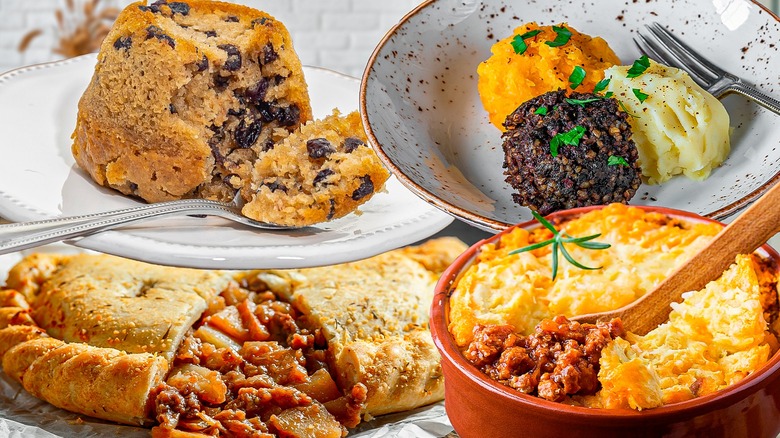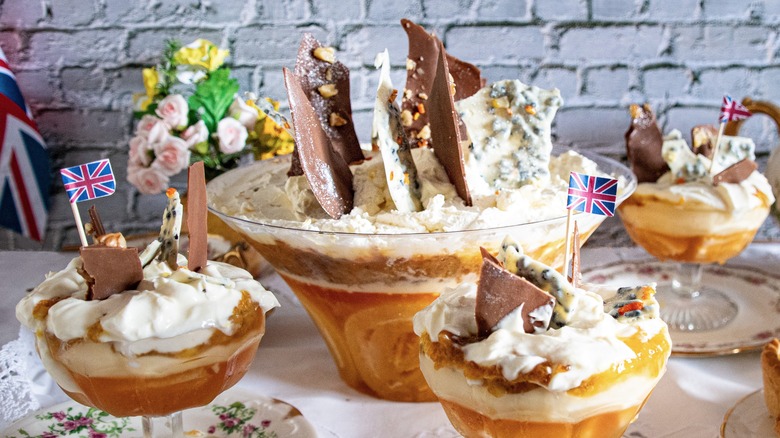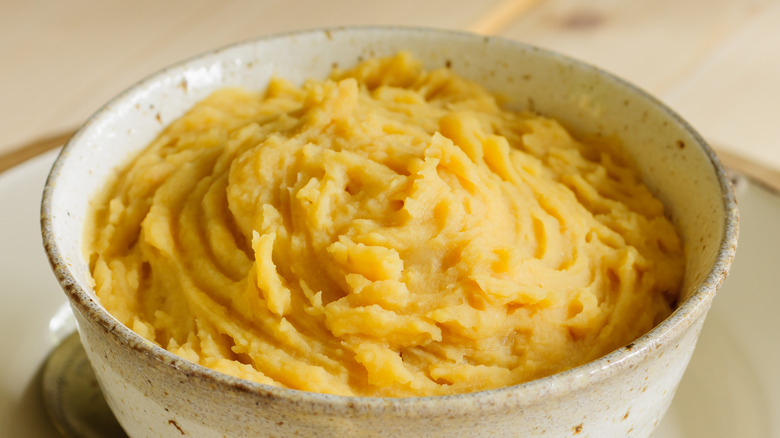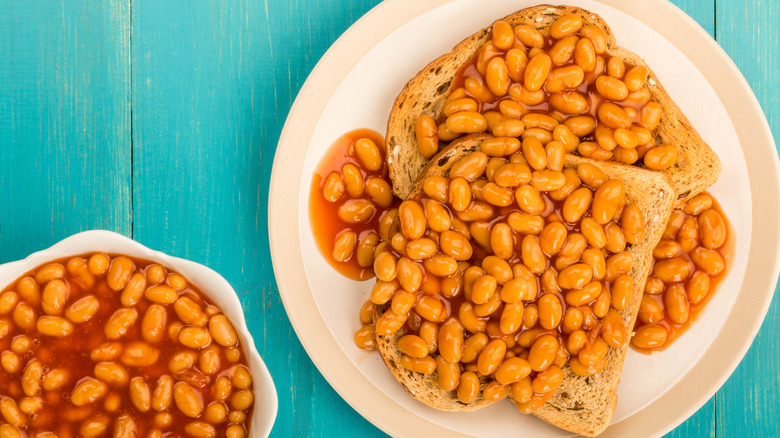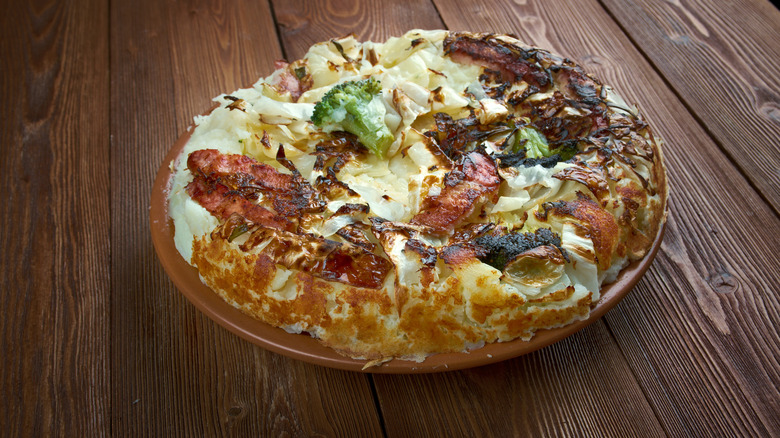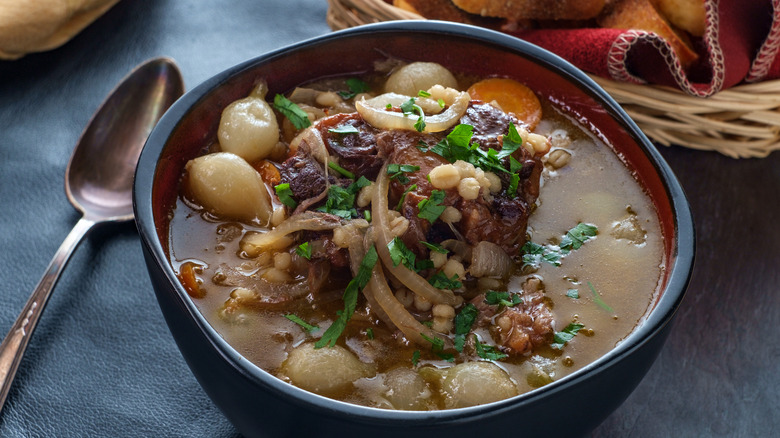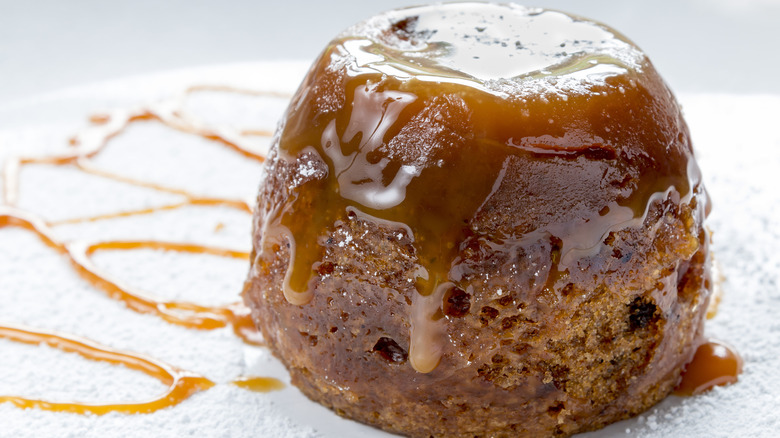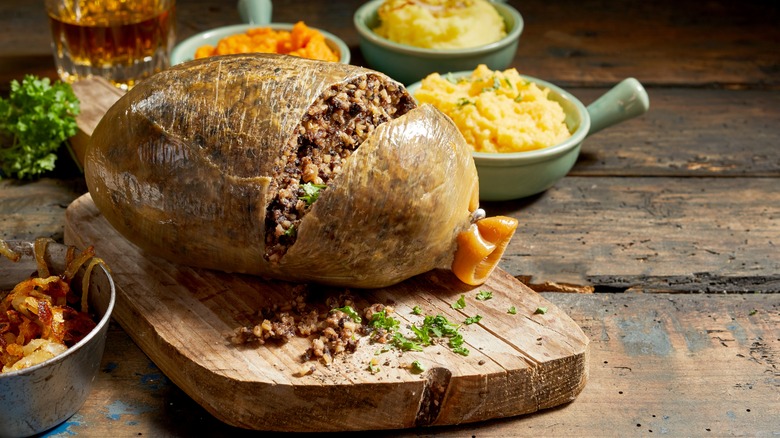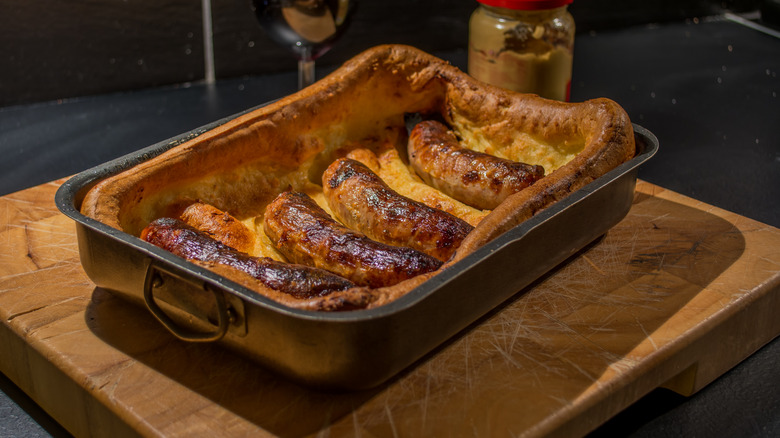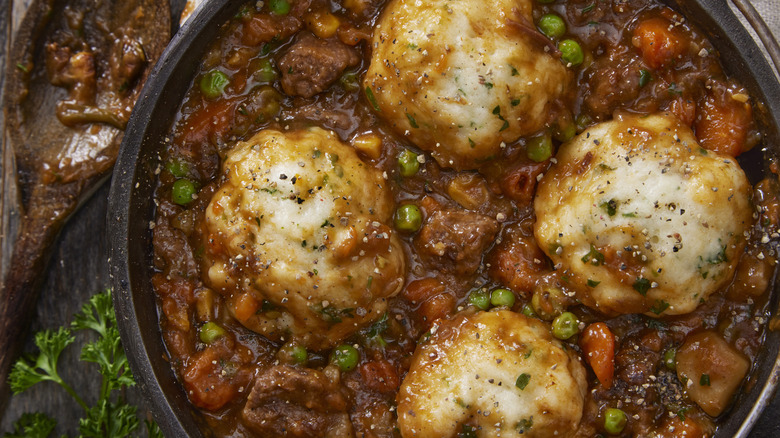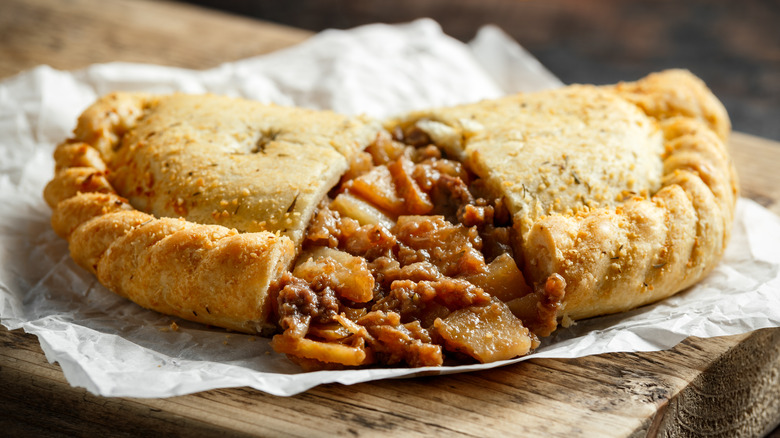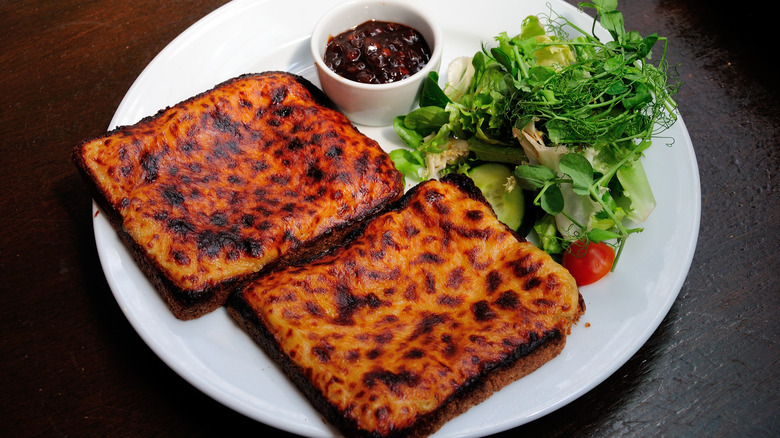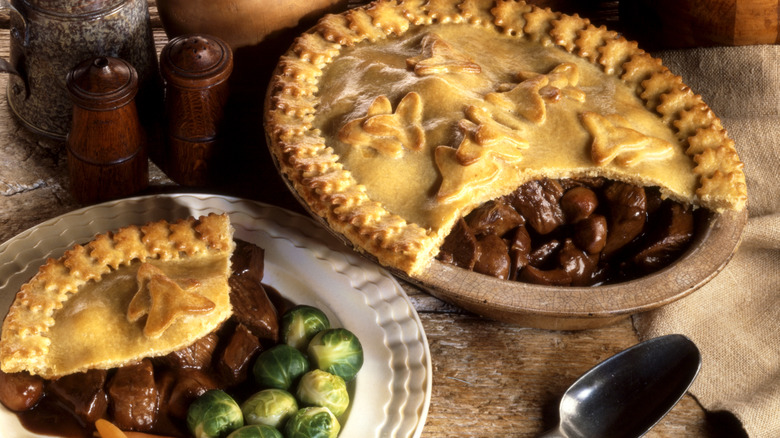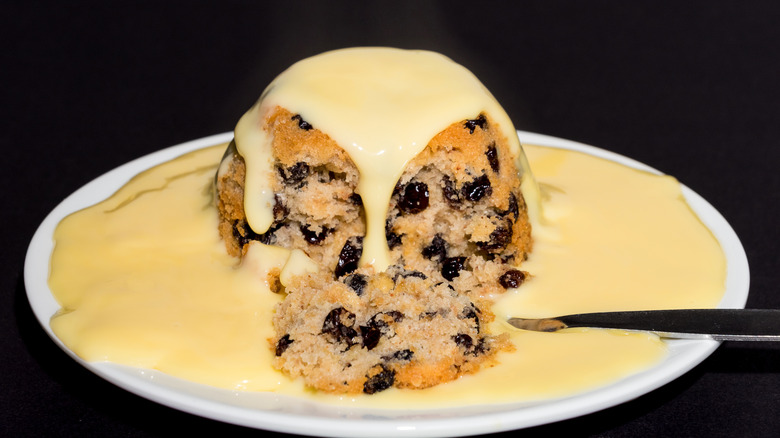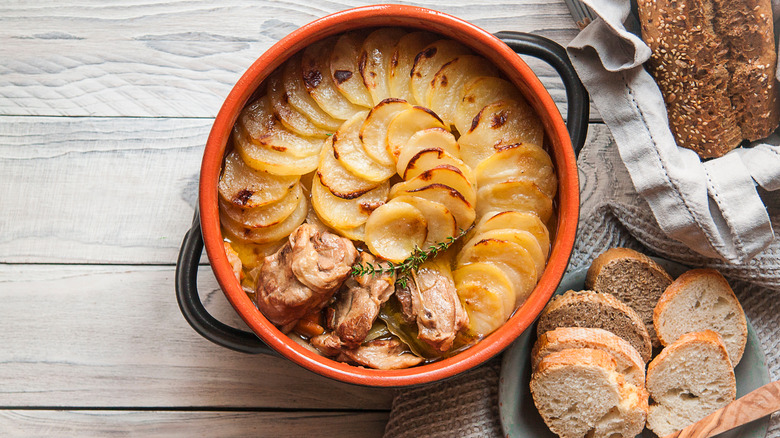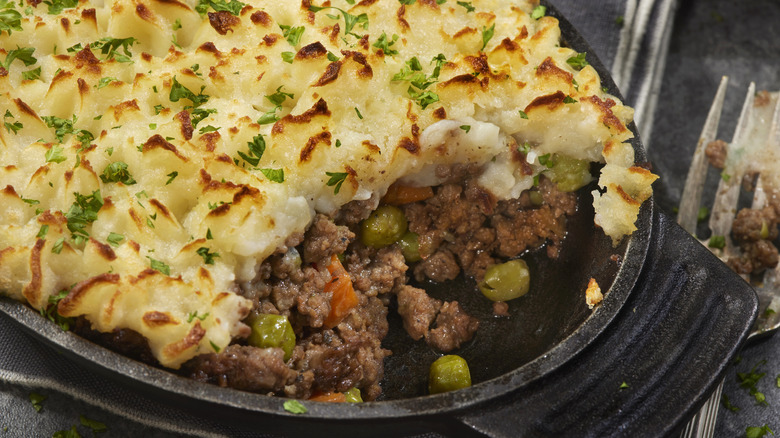15 Best British Comfort Foods, Ranked
British cuisine gets a bad rep. If you've never encountered the culinary delights of Great Britain, you're probably picturing boiled meat, overcooked vegetables, and lots of nondescript fried things. Reality couldn't be further from the truth, and Britain is actually home to some of the world's best comfort foods. This should come as no surprise, as you need something to pick you up while living on an island that switches between grey, overcast, summer skies and the darkness and drizzle of a British winter.
Some British classics, like fish and chips and the Sunday roast, haven't made our list because not all staples or traditional meals are comfort foods. Instead, comfort foods need to be something that brings warmth, joy, and a general feeling of contentment. So on this list, you can expect a good heaping of nostalgia, mental images of a warm fireside, and plenty of rich gravy. Even if you don't live in the United Kingdom, a lot of these dishes can be made at home — though at least one is illegal in the United States. Still, here are our picks for the best British comfort foods of all time.
15. Trifle
Trifle is a simple dessert that reminds everyone of childhood but is just as fun and delicious when you're on the wrong side of 30. Adults can also douse their version with booze, which ups the comfort factor no end — especially around Christmas time. Trifle makes everyone happy whenever it's encountered, and if that isn't a comfort food we don't know what is.
The layered dessert begins with a few "lady fingers" like the ones you'll find at the bottom of a tiramisu, or some crumbled cake at a push. On top of that goes jello, and a few generous handfuls of fresh fruit if you're feeling fancy. When that's set, a layer of thick custard should make up the third layer, before the dish is capped with whipped cream, and any decorative toppings you want to add. Just remember to piece it together at the last possible moment. You should never build a trifle too far in advance.
14. Pease pudding
Pease pudding is an odd one, as most people in Britain don't know what it is. The yellow split pea-based dish is pretty exclusive to North East England, but it's safe to say the rest of the British Isles, and the rest of the world, are missing out. Making pease pudding is pretty easy — the traditional method involves washing and boiling the peas, then mashing them into a paste. Butter is then heated with a bay leaf, some onion, and some thyme in it until it begins to color. The butter is then added to the pea mash with an egg and some nutmeg. The paste is then seasoned with salt and black pepper, wrapped in muslin, and added to a pan with a gammon joint (a ham, basically), a clove-studded onion, and more salt and pepper.
The result is a delicious paste that can be served hot with the ham, or chilled in the fridge and used to add a delicious layer to subsequent ham sandwiches. If it sounds like a lot of hassle, the good stuff is available from all decent butchers in the North East. Avoid the canned stuff though, it's bland and unpleasant. As a bonus, pease putting essentially acts as condensed pea soup if you want to water it down and heat it up with a few ham scraps.
13. Beans on toast
Comfort foods should be simple and nostalgic. They're there to bring you happiness during a bleak time, so you may not want to risk a complex recipe going awry or adding any additional stress. Equally, the nostalgia is there to bring you back to a time when everything was going well. Beans on toast ticks both of these boxes, even though Americans tend to look at you a bit weirdly whenever the dish is mentioned. You just toast and butter some bread, and heat some beans in the pan. Done.
It's worth noting you need specific beans, and specific bread to get the true experience. American baked beans can be very sweet, as can most American breads that aren't on sale for $8 a loaf. If you want a true beans on toast experience stateside, look for Heinz' baked beans and shop for bread that isn't heavily sweetened. Once you've slapped the beans on the toast, add a generous drizzle of HP brown sauce (which is not A1 Steak Sauce thank you very much) and a good dusting of white pepper. Some people add cheese, but this is about tradition, simplicity, and nostalgia. Cheese is just decadence.
12. A fry up/bubble 'n' squeak
If you scan this list, you may notice a Sunday roast isn't present. That's because it isn't a comfort food, it's more of a weekly family gathering centered on roast meat and potatoes. However, its leftovers have a well-earned place in the British comfort food hall of fame.
Picture the scene: it's Monday, your family has finally left you in peace, and your stomach is starting to grumble. All of the leftovers from yesterday's feast are then slapped haphazardly into a frying pan and cooked through. This reheating process also creates a delicious crust on the outside of said jumbled, mashed up, mess. In a separate pan, you reheat the leftover gravy — even though leftover gravy is a myth. None of that heavenly liquid ever survives the main meal.
Anyway, this is a fantasy, so let's use creative license to assume a delightful splash of hot gravy ends up coating the crispy fried vegetable jumble. This is a fry up in some parts of the country, and a "bubble 'n' squeak" in others. Whatever it is, a few forkfuls will transport you to heaven and make any bad feelings you're harboring disappear.
11. Oxtail soup
If you want a rich, centuries-old, English food that will bring you great joy and comfort as you eat it by a roaring fire, then you need to try oxtail soup. The "oxtail" is a traditionally tough, unpleasant, part of the cow that was basically discarded. As a result, less affluent people did what they usually do and turned something that was once sneered at into a delicious, slow-cooked, masterpiece.
The sauce is usually red wine and tomato-based, so expect a deep, rich flavor with some very subtle spicing. The collagen-heavy cut also breaks down during the stewing process, giving the soup a delightful thickness and excellent mouthfeel. Don't expect large chunks of meat — it's oxtail. Instead, you get tender, flavorful, little shreds, that are a marvelous treat when you find one on your spoon. In terms of vegetable content, there aren't really any hard and fast rules, but carrot is a common choice.
Unfortunately, oxtail is still in the midst of a popularity surge and its price now rivals ribeye. So oxtail soup is still deeply delicious and comforting, but that comfort may disappear once the bill lands on your table.
10. Sticky toffee pudding
England has a long history of steamed puddings. Pudding in this sense is more like a steamed cake than the collapsed mousse-like stuff you'll see at the grocery store. And, believe it or not, they're actually very simple to make. The mix is just a cake mix, with butter, dates, and brown sugar added. Whole dates can also be added in, but they tend to be pureed and incorporated into the mix. The whole thing is then doused in a sweet toffee sauce. American recipes call for baking this mixture, but if you want an authentic English experience, it should be steamed.
Steaming has a few benefits. Firstly, as long as you keep water in your steamer it's basically impossible to burn your putting. Secondly, the texture is different and complements this dish well. Thirdly, the sauce tends to be added to the pudding basin prior to the mix and incorporates into the pudding a little during the cooking process. If you don't have a few pudding basins handy, you can coat the inside of a coffee cup with butter, add the sauce and mixture, cap it with an aluminum foil lid, then steam it in that.
9. Haggis
Scotland's contribution to British comfort food comes in the form of its national dish. If you can get past the fact it's made from a variety of sheep innards, haggis is very enjoyable. It's a deeply savory dish, which is traditionally served alongside mashed potato and turnips — or "neeps and tatties" in the local lingo. Unsurprisingly, it also pairs well with a good single malt.
Haggis forms a key part of the traditional Scottish breakfast — but is at its best as an evening meal. It's the centerpiece of a Burns Night celebration where it's ceremonially cut as a man in a kilt recites Scottish poet Robert Burns' famous ode to the "Great Chieftain o' the Puddin-race." So if you're in Scotland during January, it's a dinner and a show, and a delicious way to get through what is a dreary month at that latitude. Sadly, true haggis is illegal to sell within, or import into, the United States. The Food and Drug Administration is still a bit squeamish about offal and has decided you should be too. So a trip across the Atlantic is currently the only way to enjoy this great dish.
8. Toad in the hole
Despite what the name suggests, this isn't a portion of French cuisine that's managed to hop its way over the channel. Instead, toad in the hole is a baked fusion of two of Britain's most beloved menu items — and could even be used as a sort of peace symbol if you try hard enough. To create this classic comfort food, you need to pour Yorkshire pudding batter (eggs, flour, and milk with a dash of salt and pepper) into a baking dish then lay a few good quality sausages into the batter. If you can find them, Lancashire sausages are an excellent choice and create a situation where the two sides that fell out during the Wars of the Roses will finally unite within your oven. Whatever you choose, don't open the oven door too early or the pudding element will deflate like a souffle.
Even if you opt for a different sausage variety, this is still a great dish. Once baked, cut it into squares, douse each portion with a liberal amount of beef and onion gravy, and enjoy one of the most pleasurable eating experiences Britain has to offer.
7. Mince and dumplings
Like a lot of items on this list, mince and dumplings are a fairly simple home-cooked staple — as true comfort foods should be. For the mince portion, expect ground beef and onions served in a thick, rich, gravy. Liberal amounts of salt and white pepper should also be added, this dish is heavy on the savory side.
The real star here is the dumplings, which are filling, soft, and soak up bits of the gravy beautifully. British dumplings tend to be made from a combination of suet and flour. The thick dumpling mix is dolloped into a pan of cooked mince, and the result is then baked which leads to a hard, crusty, outside and a soft, chewy, middle. You can also simply boil the dumplings in the mince if you don't want the hard crust. This style of dumpling also appears in various soups and other liquid dishes.
6. The Cornish pasty
The British love wrapping things in pastry, and the pasty is basically a pie that has been cooked outside of a tin. There is a lot of overlap with the fillings, with steak, chicken, corned beef, and cheese all being popular options. More outlandish variants include bakery chain Greggs' sausage, bean, and cheese melt.
As far as different styles of pasty go, the most standout type is the Cornish variety. You can spot a Cornish pasty because of its thick crust. Legend has it they were baked this way so they could serve as lunch for the local mining community. The large crimped pastry piece could be used to hold the pasty, and doing so would avoid contaminating the rest of it with your coal dust and other assorted filth-covered fingers. The pastry handle would then be thrown away at the end. These days, Cornish pasties can be a higher-end variant of the dish and that extra wedge of pastry is sometimes eaten. They don't come with a dipping sauce, as you get with a pizza crust, and to be honestr that's the one innovation the British baking scene truly needs at the moment.
5. Welsh rarebit
If you want to make it through a dull winter, you want something fatty, cheesy, and texturally sensational. Welsh rarebit is what you're looking for. It's basically an upscaled version of the British classic cheese on toast, and the two are often confused. Instead of just lobbing a few slices of reasonably priced cheddar on toasted bread, you have to put more effort in to get a true interpretation of the Welsh national dish.
Welsh rarebit, done correctly, involves a thick slice of toasted bread at the base. On top of that, you'll need to add a thick cheese sauce. The sauce is where creativity comes in. If you want to keep things "basic," just melt a generous amount of shredded cheddar into a bechamel and pour that on top. You can make things more complex and delicious by adding things like Worcestershire sauce, beer, and mustard to the sauce. Once the sauce is slathered on top, slap the now-covered toast under a broiler to crisp it up. Pull it out once dark spots start to appear on the volcanic cheesescape.
4. Steak and kidney pie
Britain has a fantastic reputation for savory meat pies, and each of those pies is a meal in itself. You have things like the Scotch pie, which is a hard-crusted combination of lamb and potatoes. Beyond that, there are mince pies, which contain ground beef and rich gravy; chicken and leek pie, which pairs mild poultry with onion's odd cousin in a creamy sauce; and various interpretations of the term "meat pie." On the top of the pile, you have steak and kidney, which demonstrates another fantastic use of offal, and is a standard comfort food in this part of the world.
The kidneys bring bursts of earthy, gamey, flavor to the dish, and the organ's ultra-tender texture often contrasts well with the firmer beef. Beef kidney is also traditionally used in the pies as opposed to lamb or pig, as the slightly more robust cow organ holds up better during the long stewing process and subsequent baking.
3. Spotted dick
Underneath the suggestive name is a traditional British classic. Spotted dick is a steamed pudding consisting of flour, suet, and raisins or currants at a basic level. The zest of an orange and lemon can be added to give the traditional dish an extra kick, and it is traditionally served doused in a thick custard. The result is something denser and chewier than a cake, with an occasional refreshing fruity burst.
While classic suet tends to be made from the fat which surrounds a lamb or calf's kidneys, vegetarian suets are available — so there's no need for the meat averse to miss out on this classic comfort food. You may be curious where the name "spotted dick" comes from, and you may also be disappointed to hear it's a bit more mundane than you may expect. Dick is short for "puddick," which is an Old English word for pudding. The spotted part comes from the currants or raisins, which give the pudding a spotted appearance when mixed in.
2. A Lancashire hotpot
A Lancashire hotpot is a potato-capped lamb casserole that is packed with lamb, onions, and deliciousness. The original Victorian recipe also contained a healthy amount of oysters, which were very cheap at the time. Other traditional variants included things like kidney, which was a cheap additional protein. Almost every version you'll encounter today consists of stewed lamb, vegetables, and that all-important layer of potato slices. Everything under the potato should be bound together with a rich, thick, gravy.
After being assembled, the dish is baked until the tops of the potatoes are crispy. It's one of those all-in-one meals, like a lasagne. Everyone in the house should be salivating at the smell and more than satisfied with the generous scoop of meat and vegetables they're served when it's done. If you want to play around with variants on the hotpot, its gravy is a good place to start. Adding mint goes very well with the lamb inside, and you could even create a spicy variant if you really wanted to.
1. Shepherd's pie/Cottage pie
There's arguably nothing better on a drizzly, cold, English evening than tucking into a shepherd's or cottage pie. The dish is an all-in-one meal that is warm, filling, and bursting with flavor. In short, it's an ideal comfort food. You may be wondering: What is the difference between shepherd's and cottage pie? Well, it's all down to the meat. Shepherd's pie, as the name may suggest, is traditionally made with ground lamb, while cottage pie uses ground beef as its key ingredient.
The meat in question is fried up with onion before stock, carrots, and peas are added along with seasonings. Worcestershire sauce is also a common addition, providing a great depth of flavor and a vital hit of acidity to the dish. Once the ground meat is prepared, it's left to cool before a layer of creamy mashed potato is added on top. A sprinkle of shredded cheese to add some extra texture and flavor to the potato is optional. Once assembled, the pie is baked until the potato develops a crust and the full dish is heated through.
